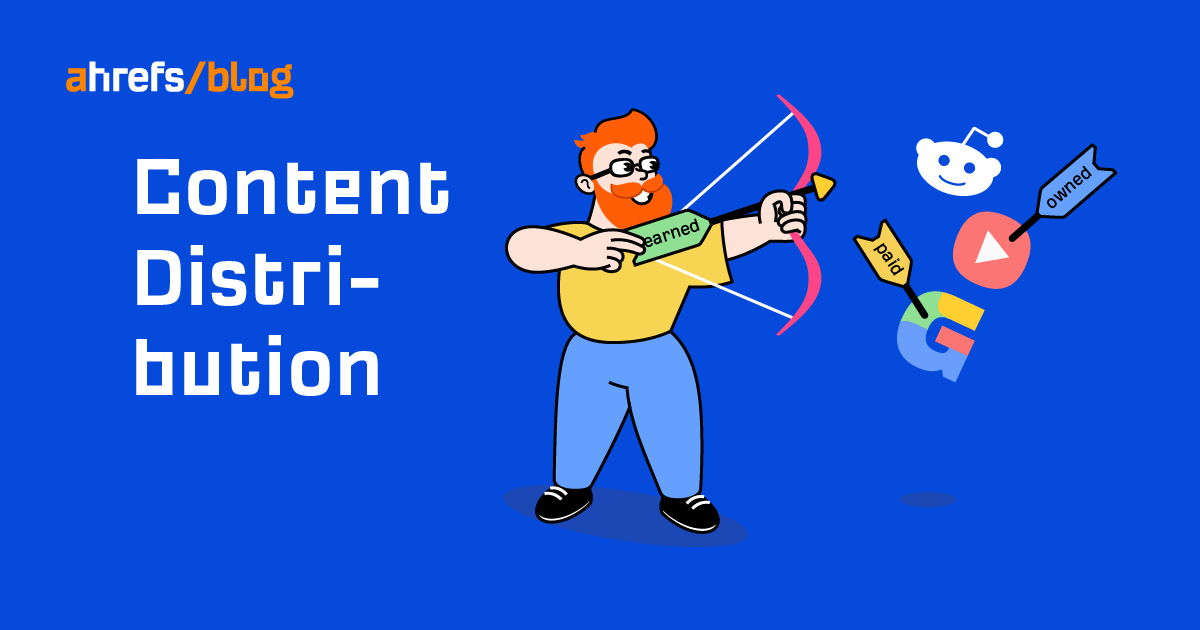You may have heard the expression, “The best content doesn’t win; distribution does.”
This is why simply creating great content isn’t enough. You need a distribution strategy to make sure your content actually reaches its intended audience. Otherwise, you’ll just be wasting your time and money.
In this guide, you’ll learn what content distribution is and how to create and launch a winning content distribution strategy:
Content distribution is the process of publishing and promoting content in various formats across multiple channels to reach as many people as possible.
The primary distribution channels are owned, earned, and paid channels.
Owned channels
An owned channel is one that you fully control.
Examples of earned channels include:
- Website or blog
- Email list
- TikTok
- YouTube
Website or blog
Your website is the primary channel you own.
Ahrefs customers use the SEO tools on our website, but we also publish and distribute content here.
There are five main types of content on our website.
- Guides – Resources to help customers get more organic traffic to their websites
- Data studies – Unique insights and statistics about our industry
- Product information – Updates about new product features
- Free SEO tools – Interactive tools to let potential customers sample our paid service
- Visual content – Charts, images, and infographics to help explain complex topics
Email list
A subscribe box is located on the top navigation bar and the sidebar of many articles on our website.
When a reader provides their email address, we offer, in exchange, a weekly newsletter where we share valuable SEO and marketing resources and product updates.
For example, December’s email newsletter featured our new Traffic Potential metric and a roundup video and blog post of product updates.

Ahrefs newsletter sent Dec. 9, 2021.
Ahrefs has 93K followers on Twitter, and we distribute a variety of content there.
We publish article summaries and link back to the articles on our website.
70 Blogging Statistics for 2022
Curious about the state of blogging this year? Check out @siquanong ‘s curated list of useful statistics across 10 categories, including:
– Blogging revenue
– Blogging length and frequency
– Guest blogging https://t.co/E3xc9QwR5E— Ahrefs (@ahrefs) February 4, 2022
We also publish tweet threads. Each thread is a series of connected tweets similar to a step-by-step guide.
Inbound marketing lessons from IBM ✍🏻
In 2021, @BryanCasey_ and his team added >$50 million of annual organic traffic value to https://t.co/QMohyJuxjL.
In the process, they also generated $250m of lifetime traffic value (LTTV). So, how did they do it? 🧵
— Ahrefs (@ahrefs) February 2, 2022
TikTok
You’ve likely heard of Miss Excel, who publishes Excel tips on TikTok.
She regularly earns over 100K plays per TikTok post.
YouTube
YouTube is a channel where we distribute video content to viewers and our subscribers.
In addition to tutorials on using our tools, we publish case studies and experiments we hope resonate with our audience.
Notably, many of our videos are repurposed from existing articles.
Earned channels
An earned channel is where your content gets featured because it’s good enough to be approved by an editor, gatekeeper, or moderator.
Examples of earned channels include:
- Facebook groups
- Forums
- Guest posts
Paid channels
A paid channel requires payment to distribute content.
At Ahrefs, we sometimes invest in paid channels to distribute our content so we can reach as many relevant people as possible.
Examples of paid channels include:
- Twitter Ads
- Google Ads
- Quuu Promote
- Sponsorships
- Retargeting
- Native advertising, e.g., Taboola and Outbrain
With so many channels available to distribute content these days, knowing where to start can be a bit overwhelming. So let’s look at how to create a simple, winning content distribution strategy step by step.
Step 1. Publish content on your primary owned channel
Every business should start by choosing an owned channel to focus on, and then decide what content to post there.
And 9 out of 10 times, this will usually be:
- Website/blog
- YouTube
- A social media account (Twitter, Tiktok, Instagram, etc)
The best channel for you will depend on the type of content you already produce and whether you have the expertise to create more content for that channel.
For example, if you’re camera shy, then YouTube probably isn’t the best choice. You’ll want to stick to writing and publishing on your website or blog instead.
Our primary channel is our website/blog, so this is where we first distribute most of our content.
PRO TIP
If you’re distributing content via your website or blog and want people to find you, it pays to optimize the content for SEO. If you can rank on Google for your keywords, your content will get a lot of organic traffic every month.
For example, our guide to Google search operators ranks in the top 100 for over 2K keywords and gets an estimated 8.8K monthly visits from organic search, according to Ahrefs.

Looking at the organic traffic history chart, we can see that traffic has fluctuated over time, but the article has been getting thousands of organic visits each month since December 2018.

In other words, optimizing this post for SEO resulted in hundreds of thousands of readers. And we did so by publishing and distributing on just one channel.
Recommended reading: How to Write SEO Content That Ranks
Step 2. Push to email and social media
Next, you need to get your content out there by distributing it to your secondary owned channels: your social media channels and email list.
The purpose of distributing to these channels is twofold:
- You can share key insights and messages from your content directly with your followers and subscribers.
- You can drive traffic back to where your main content lives.
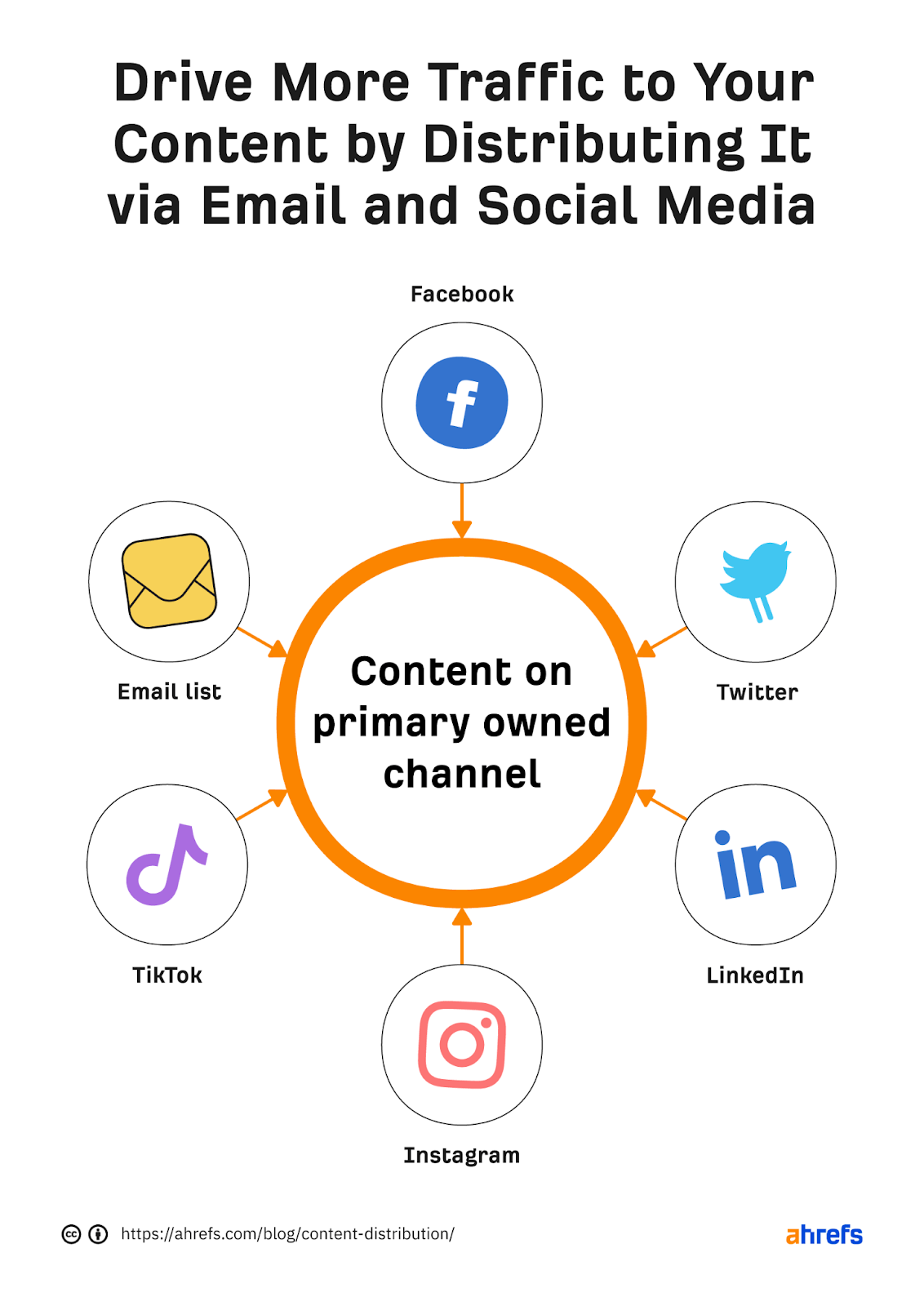
For example, we push all new blog posts to our 93K Twitter followers:
12 Marketing Podcasts Worth Your Time by @RebLiew
We vetted over 45 marketing podcasts, then shortlisted the most insightful ones to save you time. Did your favourites make the cut? https://t.co/enHVww1BQC
— Ahrefs (@ahrefs) February 9, 2022
Our 98K Facebook followers:
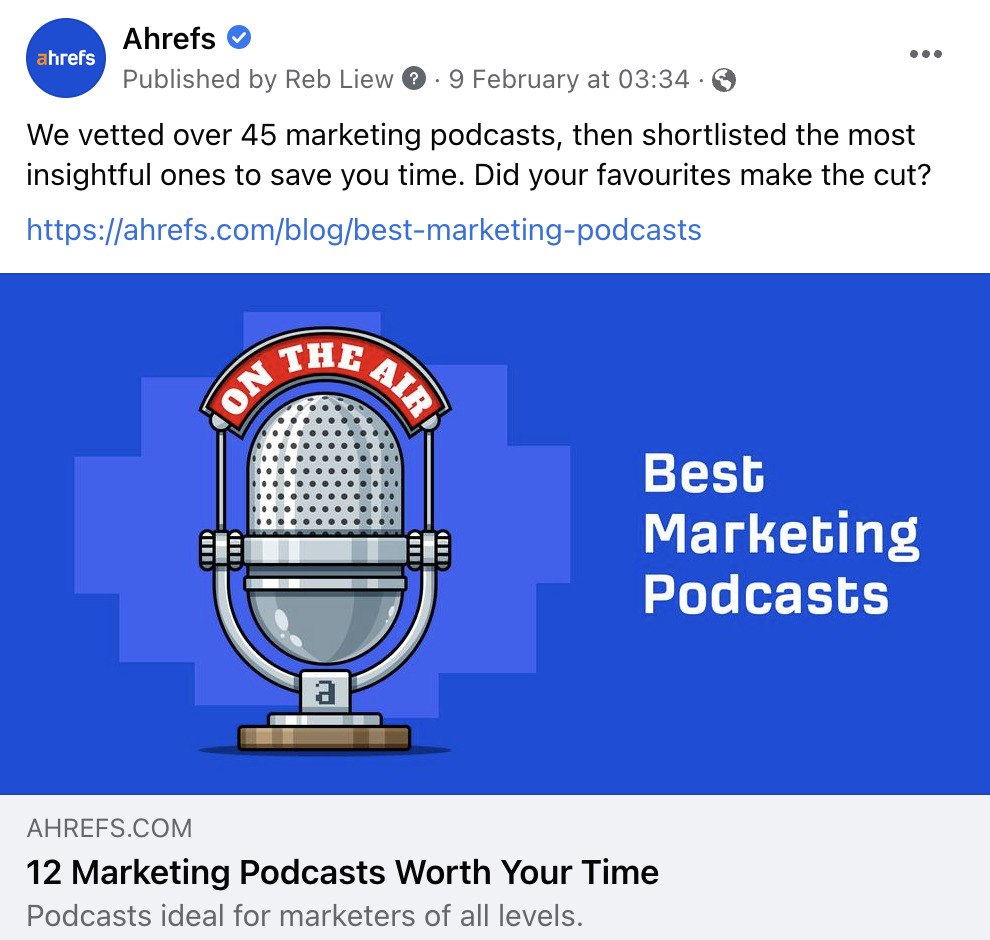
Our 87K LinkedIn followers:
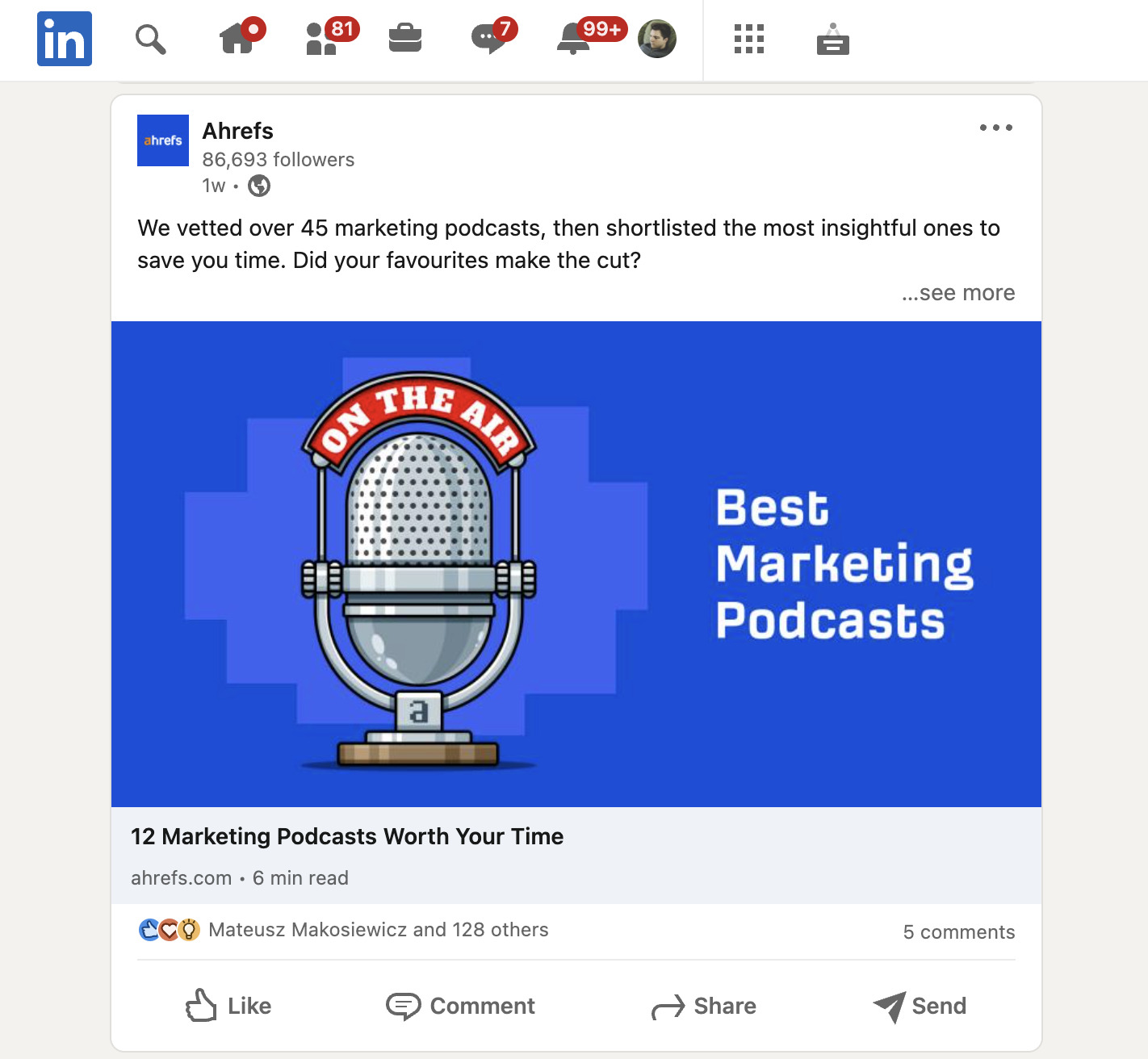
And our ~170K newsletter subscribers:
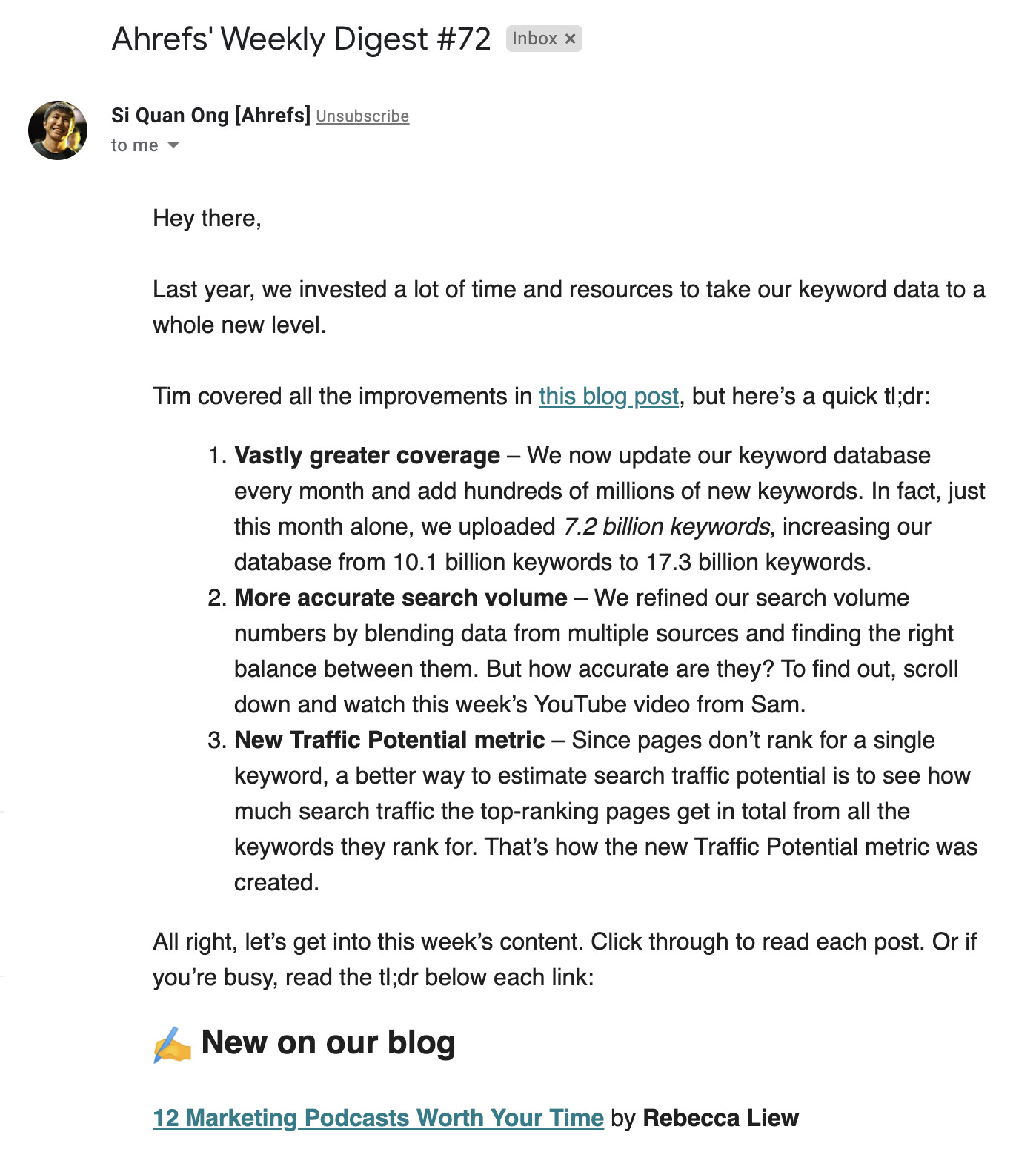
The distribution channels will vary, depending on who you target and where they hang out online.
Our channels are Facebook, Twitter, LinkedIn, and email because they make sense for us. We don’t distribute content to Instagram, Snapchat, or TikTok because they are not where our audience primarily lives.
Step 3. Push to earned channels
It’s a little harder to distribute on earned channels because your content needs to be approved by a gatekeeper. Here are a few examples where we (Ahrefs) pushed content to earned channels.
When our chief marketing officer, Tim Soulo, distributed his keyword research guide, he created a short, simplified version of the post for /r/bigSEO.
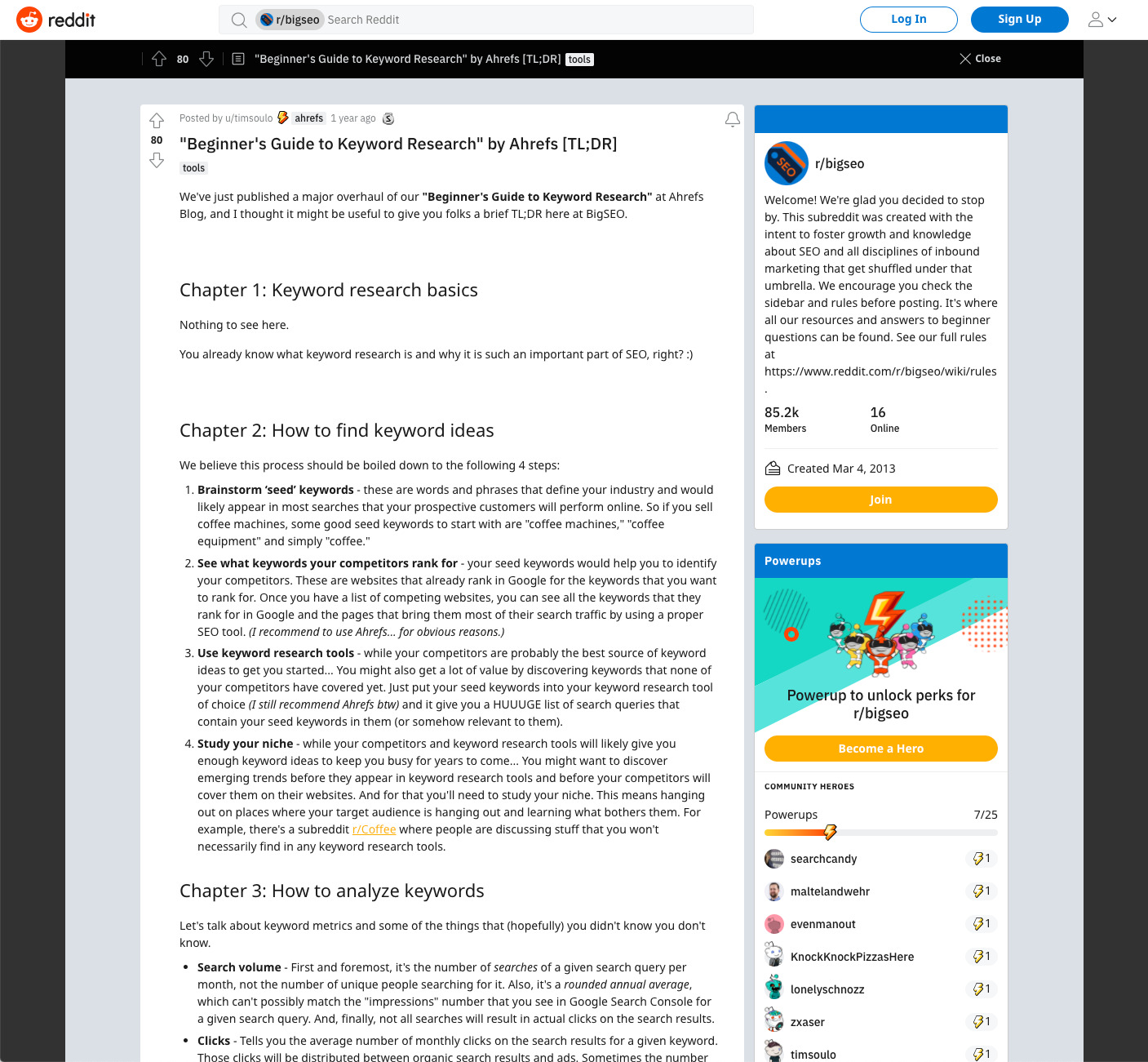
If this didn’t include valuable information for the subreddit, the moderators would have never approved it—hence why Reddit is an earned channel.
The same is true for channels like third-party Facebook groups.
Facebook groups
Before joining Ahrefs, our head of content, Joshua Hardwick, created a video that he wanted to distribute to the SEO community. So he showed his video to the owners of third-party SEO Facebook groups and asked for permission to post in their groups.
As the content was valuable, many owners happily let him post the video.
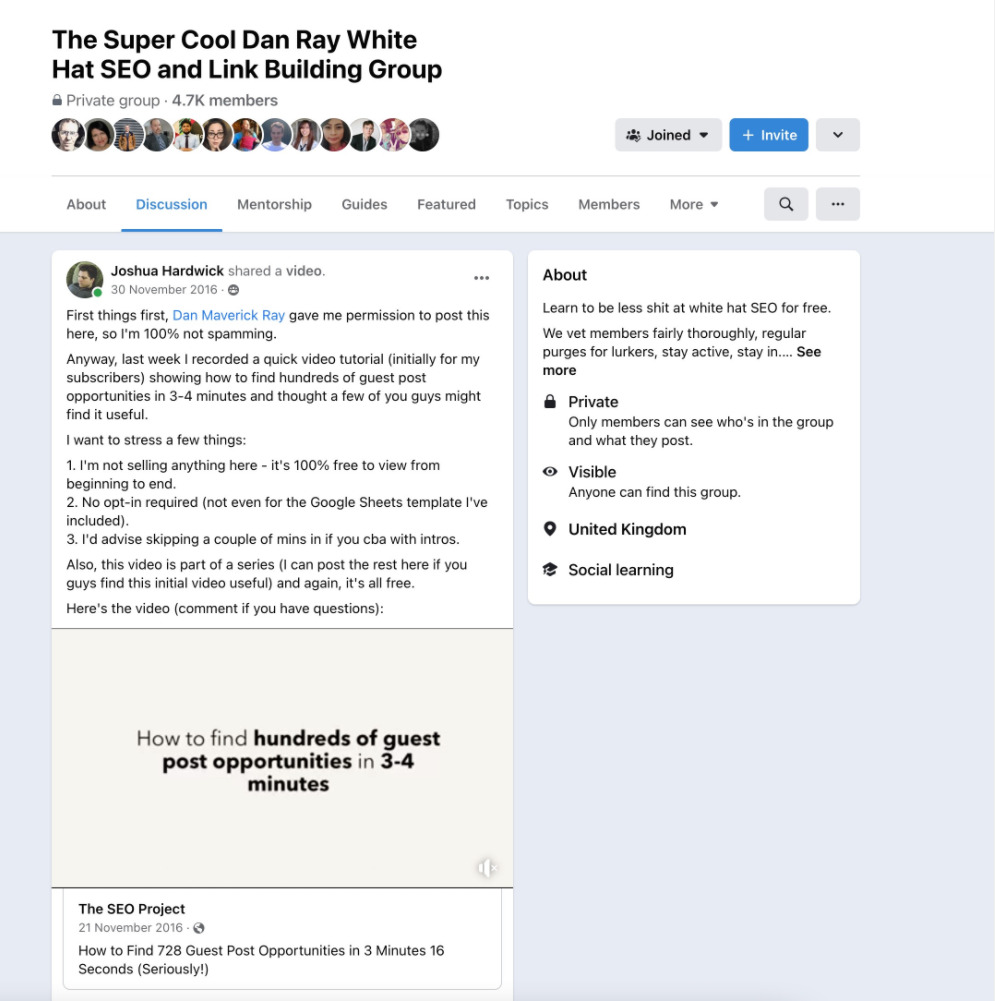
Joshua’s video shared in a Facebook group with 4.7K members.
Other earned channels you can push to include the following:
- Forums (e.g., Quora)
- Third-party newsletters
- Other blogs (via guest posts)
Guest blogging
Guest blogging is where you write a post for another blog in your industry. It’s a great way to further distribute content and ideas, especially if you can get published on a site with a large audience.
To find relevant sites to pitch your guest post to, look for those that have already published articles about similar topics.
For example, if we wanted further distribution for the ideas shared in our keyword research guide, we could look for websites that published articles about link building because they’re likely to be interested in a post about a similar subject.
Here’s how to do this in Ahrefs’ Content Explorer:
- Enter a related topic (e.g., link building)
- Change the dropdown to In title
- Filter for only one page per domain (no point pitching to the same site twice)
- Go to the Websites tab
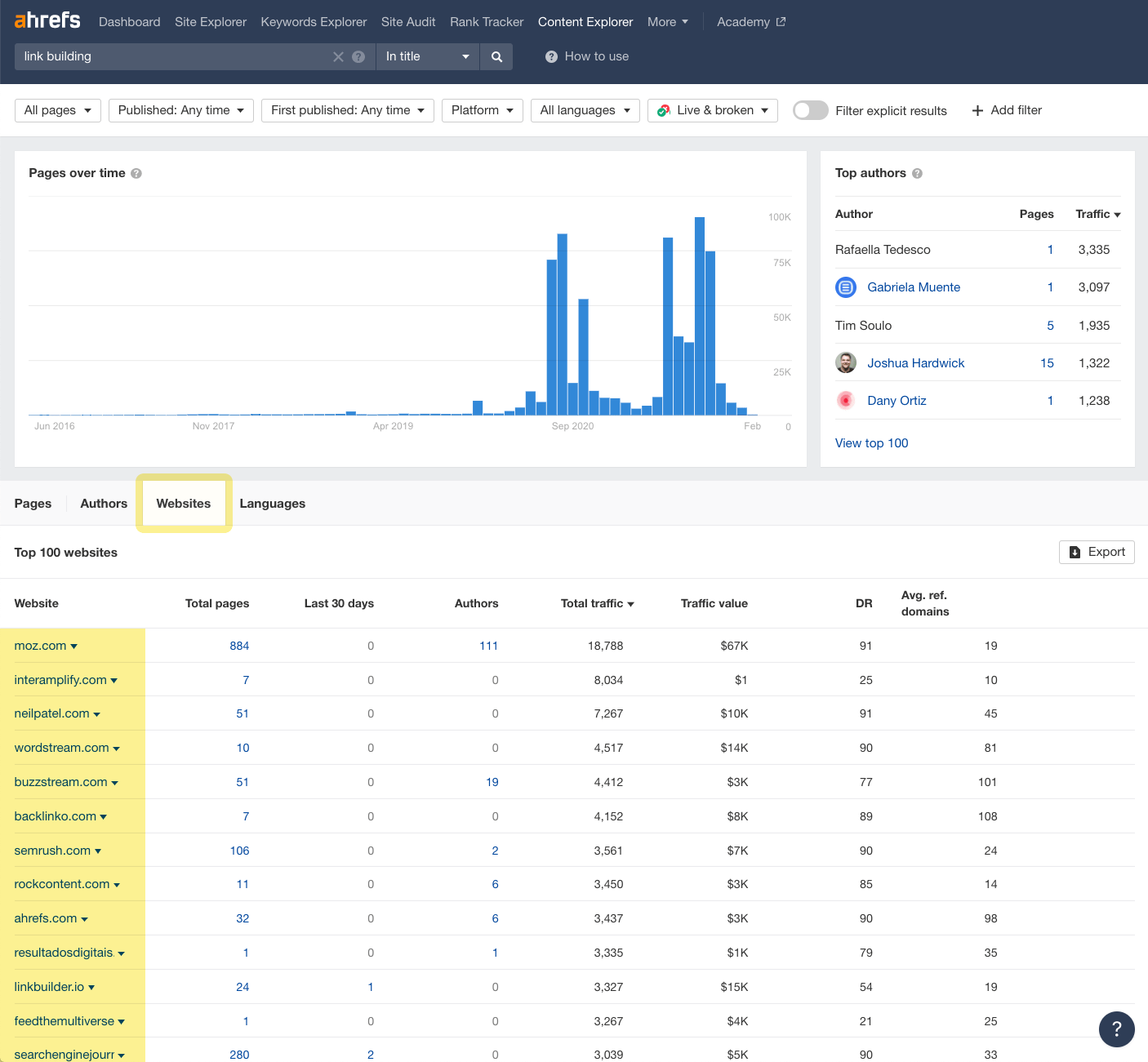
Recommended reading: Guide to Guest Blogging for SEO
Step 4. Push to paid channels
When distributing content to owned and earned channels isn’t cutting it for you, it’s time to step it up with paid channels.
Quuu Promote
One of the cheapest and easiest paid channels to use is called Quuu Promote.
For $50 a month, you can push up to 10 blog posts to over 39K people who will share the posts with their social followers (if they like the content).

Twitter Ads
Twitter Ads can be a cost-effective way to distribute content. You can learn more about our experiments with the ads in this video.
Google Ads
Google Ads appear above organic search results on the SERP. This is a great way to reach people who are actually searching for your content.
For example, we recently distributed our free SEO tools via Google Ads:

TIP
Find potentially lucrative keywords to target with paid ads by spying on the keywords your competitors are running ads for. To do this, plug a competitor into Ahrefs’ Site Explorer and go to the Paid keywords report.
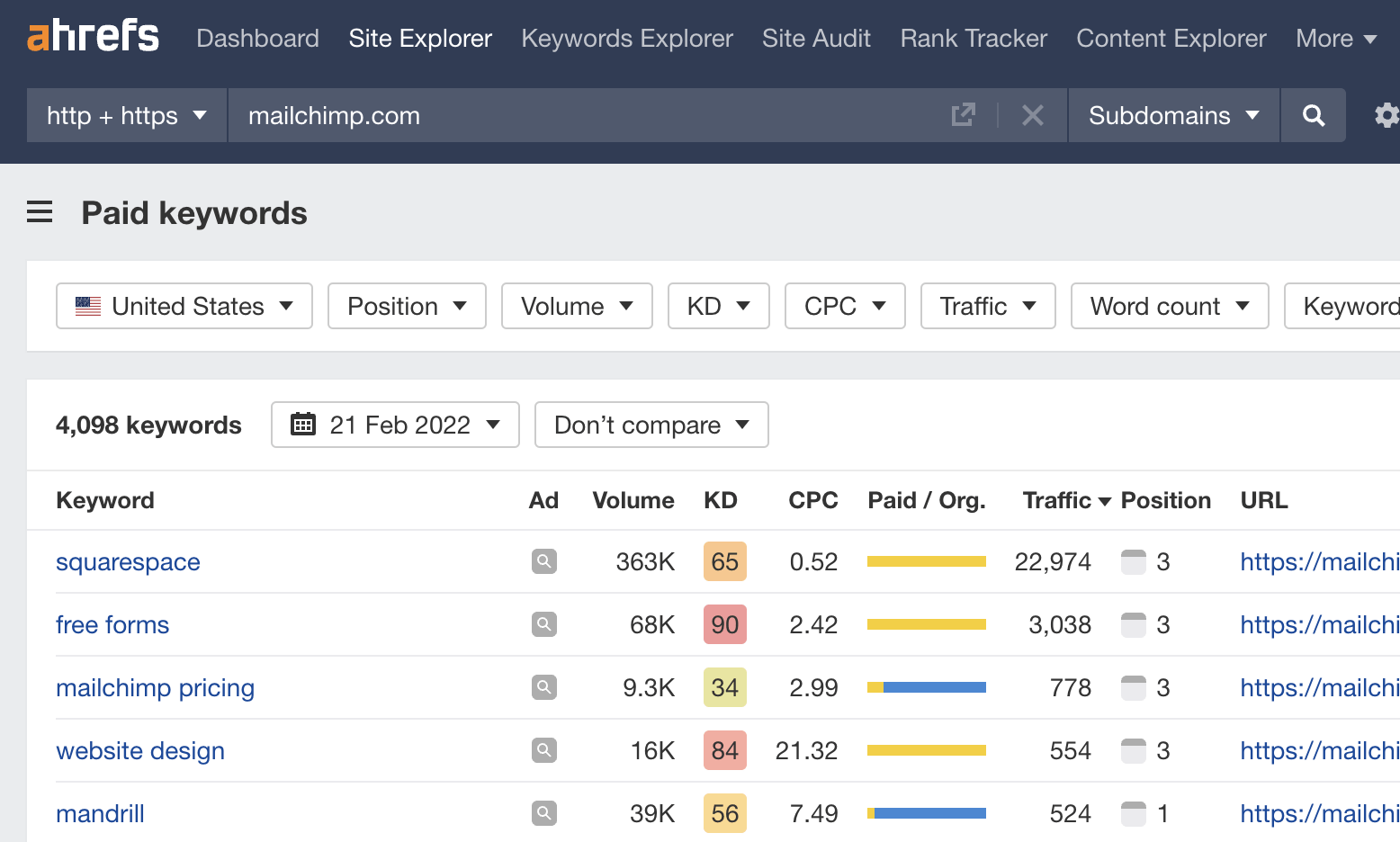
Sponsorships
We recently decided to move our paid traffic budget, using it to sponsor influencers and thought leaders in our industry.
We’ll be reallocating our paid traffic budget (~$200k💰) for December away from the Google/Facebook—and into sponsoring the industry’s best creators and thought leaders.
— Ahrefs (@ahrefs) November 24, 2021
Learn more about our results in this thread:
In December 2021 we have reallocated ~$200k (@ahrefs monthly paid traffic budget) into sponsoring creators & thought leaders in our space.
In case you missed:https://t.co/VXcP5k7OzS
Naturally, quite a few people asked me to share our results & takeaways from this campaign.
— Tim Soulo 🇺🇦 (@timsoulo) February 21, 2022
Native advertising
Native ads are advertisements that look like regular content and appear on popular websites, e.g., USA Today, AOL, MSN, Weather.com, etc.
Taboola and Outbrain are popular marketplaces for native ads.
This coffee company converted 10K new customers in six months using native ads.
Facebook ads
Facebook allows you to boost your posts to more users on its platform. To do this, click the big “Boost post” button on the post you want to promote.
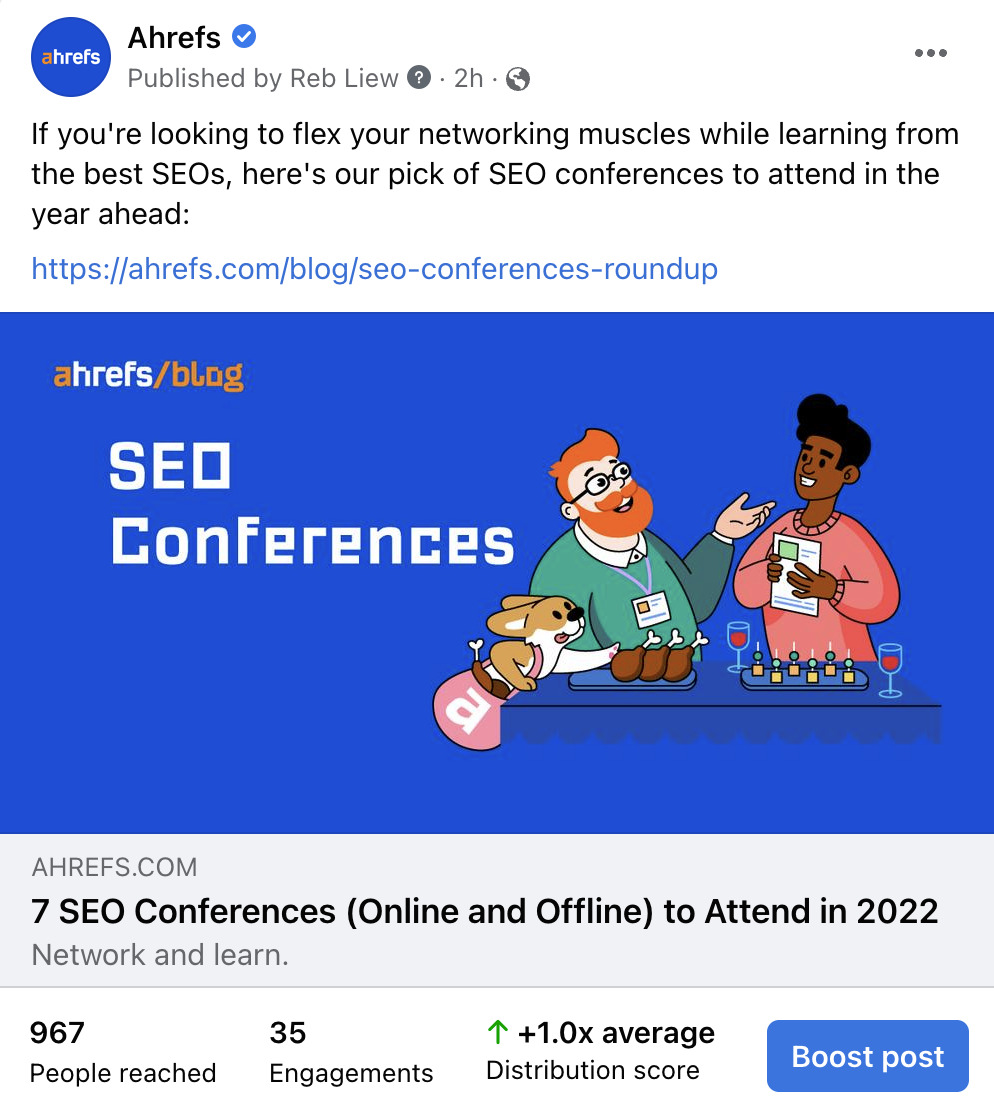
Step 5. Measure your results with tools
The purpose of content distribution is to reach more people, so it’s important to measure performance to see how effectively you managed to do that. Below are a few tools that can help.
Ahrefs
If you published content on your website or blog and optimized it for organic search, it should hopefully start ranking for relevant keywords on Google over time.
To check if this is the case, create a free Ahrefs Webmaster Tools account and plug the URL of the content you distributed into Site Explorer. The tool will show the number of keywords and estimated number of monthly organic visits the page receives.
For example, our link building guide ranks in the top 100 for 365 keywords and gets an estimated 1.3K organic visits per month:

Twitter has built-in analytics. Just click the graph icon on any post to see its reach.
For example, Joshua’s recent thread about keyword cannibalization received 275K impressions and 1.4K engagements.

Google Analytics
Google Analytics gives you all kinds of valuable insights about your content distribution efforts, including where visitors came from, how long they stayed, and whether the distribution channel helped contribute to a conversion.
Recommended reading: The Only 3 Google Analytics Metrics You Need to Track
Step 6. Repeat
And the last step is to repeat the previous six steps.
You can repeat the above either for repurposed content or another piece of content.
For example, we published this study about Core Web Vitals. Our very own Patrick Stox then created a thread on Twitter and added the key graphics from the study to each tweet.
What can you learn from the largest Core Web Vitals data study?
For one, @ahrefs pulled page level data from 43.66M unique pages, but only 5.21M or 11.9% had any Core Web Vitals metrics. 😱
Here’s a 🧵with interesting insights from the studyhttps://t.co/XB61TTu053 pic.twitter.com/E89llerFON
— Patrick Stox (@patrickstox) January 31, 2022
Final thoughts
The purpose of this article is to share key content distribution channels and insights into how to develop a winning content distribution strategy that reaches a wider audience.
The choice of platforms you use when distributing content and measuring it is entirely up to you.
If you’re creating content and don’t believe it’s being rewarded, remember this: “The best content doesn’t win; distribution does.”
